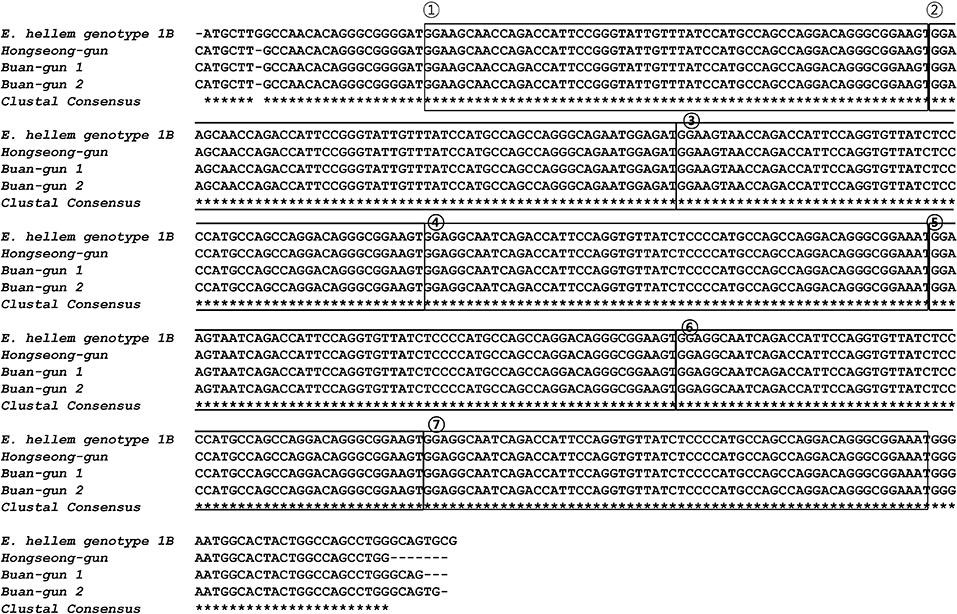J Korean Med Sci.
2015 Mar;30(3):227-232. 10.3346/jkms.2015.30.3.227.
Detection of Encephalitozoon spp. from Human Diarrheal Stool and Farm Soil Samples in Korea
- Affiliations
-
- 1Department of Environmental and Tropical Medicine & Research Institute of Medical Sciences, Konkuk University, School of Medicine, Seoul, Korea. maria205@kku.ac.kr
- 2Division of Epidemic Inteligence Service, Korea Centers for Disease Control & Prevention, Cheongju, Korea.
- KMID: 2133297
- DOI: http://doi.org/10.3346/jkms.2015.30.3.227
Abstract
- Microsporidia are eukaryotic organisms that cause zoonosis and are major opportunistic pathogens in HIV-positive patients. However, there is increasing evidence that these organisms can also cause gastrointestinal and ocular infections in immunocompetent individuals. In Korea, there have been no reports on human infections with microsporidia to date. In the present study, we used real-time PCR and nucleotide sequencing to detect Encephalitozoon intestinalis infection in seven of 139 human diarrheal stool specimens (5%) and Encephalitozoon hellem in three of 34 farm soil samples (8.8%). Genotype analysis of the E. hellem isolates based on the internal transcribed spacer 1 and polar tube protein genes showed that all isolates were genotype 1B. To our knowledge, this is the first report on human E. intestinalis infection in Korea and the first report revealing farm soil samples as a source of E. hellem infection. Because microsporidia are an important public health issue, further large-scale epidemiological studies are warranted.
Keyword
MeSH Terms
-
AIDS-Related Opportunistic Infections/parasitology
Adolescent
Adult
Aged
Agriculture
Base Sequence
Child
Child, Preschool
DNA, Intergenic/genetics
DNA, Protozoan/genetics
Encephalitozoon/*genetics/*isolation & purification
Encephalitozoonosis/*epidemiology
Feces/*parasitology
Female
Fungal Proteins/genetics
Humans
Infant
Infant, Newborn
Male
Middle Aged
Molecular Typing
Real-Time Polymerase Chain Reaction
Republic of Korea/epidemiology
Sequence Alignment
Sequence Analysis, DNA
Soil/*parasitology
Young Adult
DNA, Intergenic
DNA, Protozoan
Fungal Proteins
Soil
Figure
Reference
-
1. Didier ES. Microsporidiosis: an emerging and opportunistic infection in humans and animals. Acta Trop. 2005; 94:61–76.2. Mathis A, Tanner I, Weber R, Deplazes P. Genetic and phenotypic intraspecific variation in the microsporidian Encephalitozoon hellem. Int J Parasitol. 1999; 29:767–770.3. Didier ES, Weiss LM. Microsporidiosis: current status. Curr Opin Infect Dis. 2006; 19:485–492.4. Franzen C, Müller A. Microsporidiosis: human diseases and diagnosis. Microbes Infect. 2001; 3:389–400.5. Ghosh K, Weiss LM. Molecular diagnostic tests for microsporidia. Interdiscip Perspect Infect Dis. 2009; 2009:926521.6. Didier ES, Stovall ME, Green LC, Brindley PJ, Sestak K, Didier PJ. Epidemiology of microsporidiosis: sources and modes of transmission. Vet Parasitol. 2004; 126:145–166.7. Dowd SE, Gerba CP, Pepper IL. Confirmation of the human-pathogenic microsporidia Enterocytozoon bieneusi, Encephalitozoon intestinalis, and Vittaforma corneae in water. Appl Environ Microbiol. 1998; 64:3332–3335.8. Lee SY, Lee SS, Lyoo YS, Park HM. DNA detection and genotypic identification of potentially human-pathogenic microsporidia from asymptomatic pet parrots in South Korea as a risk factor for zoonotic emergence. Appl Environ Microbiol. 2011; 77:8442–8444.9. Jeong DK, Won GY, Park BK, Hur J, You JY, Kang SJ, Oh IG, Lee YS, Stein BD, Lee JH. Occurrence and genotypic characteristics of Enterocytozoon bieneusi in pigs with diarrhea. Parasitol Res. 2007; 102:123–128.10. Lee JH. Prevalence and molecular characteristics of Enterocytozoon bieneusi in cattle in Korea. Parasitol Res. 2007; 101:391–396.11. Hong S, Kim K, Yoon S, Park W-Y, Sim S, Yu J-R. Detection of Cryptosporidium parvum in Environmental Soil and Vegetables. J Korean Med Sci. 2014; 29:1367–1371.12. Lee SU, Joung M, Ahn MH, Huh S, Song H, Park WY, Yu JR. CP2 gene as a useful viability marker for Cryptosporidium parvum. Parasitol Res. 2008; 102:381–387.13. Hollister WS, Canning EU, Anderson CL. Identification of Microsporidia causing human disease. J Eukaryot Microbiol. 1996; 43:104s–105s.14. Xiao L, Li L, Moura H, Sulaiman I, Lal AA, Gatti S, Scaglia M, Didier ES, Visvesvara GS. Genotyping Encephalitozoon hellem isolates by analysis of the polar tube protein gene. J Clin Microbiol. 2001; 39:2191–2196.15. Haro M, Del Aguila C, Fenoy S, Henriques-Gil N. Intraspecies genotype variability of the microsporidian parasite Encephalitozoon hellem. J Clin Microbiol. 2003; 41:4166–4171.16. Kotler DP, Orenstein JM. Clinical syndromes associated with microsporidiosis. Adv Parasitol. 1998; 40:321–349.17. Weber R, Deplazes P, Schwartz D. Diagnosis and clinical aspects of human microsporidiosis. Contrib Microbiol. 2000; 6:166–192.18. Wittner M, Weiss L. Epidemiology of microspridiosis. In : Bryan RT, Schwartz DA, editors. Epidemiology of microspridiosis. Washington, DC: American Society of Microbiology;1999. p. 502–516.19. Deplazes P, Mathis A, Weber R. Epidemiology and zoonotic aspects of microsporidia of mammals and birds. Contrib Microbiol. 2000; 6:236–260.20. Yakoob J, Abbas Z, Beg MA, Jafri W, Naz S, Khalid A, Khan R. Microsporidial infections due to Encephalitozoon intestinalis in non-HIV-infected patients with chronic diarrhoea. Epidemiol Infect. 2012; 140:1773–1779.21. Friedberg DN, Stenson SM, Orenstein JM, Tierno PM, Charles NC. Microsporidial keratoconjunctivitis in acquired immunodeficiency syndrome. Arch Ophthalmol. 1990; 108:504–508.22. Liguory O, Fournier S, Sarfati C, Derouin F, Molina JM. Genetic homology among thirteen Encephalitozoon intestinalis isolates obtained from human immunodeficiency virus-infected patients with intestinal microsporidiosis. J Clin Microbiol. 2000; 38:2389–2391.
- Full Text Links
- Actions
-
Cited
- CITED
-
- Close
- Share
- Similar articles
-
- Detection of Bacterial and Viral Pathogens in Stool Specimens Using Multiplex PCR
- Isolation Rates of Fungi from Soil Near Korean Wrestling Fields, Playgrounds, and Beauty Salons in Daegu
- Prevalence of Salmonella spp. in pet turtles and their environment
- Molecular Detection and Subtyping of Human Blastocystis and the Clinical Implications: Comparisons between Diarrheal and Non-diarrheal Groups in Korean Populations
- Multicenter study on the molecular epidemiology of intestinal protozoan parasites in Korea




